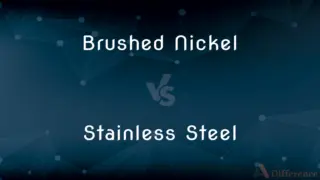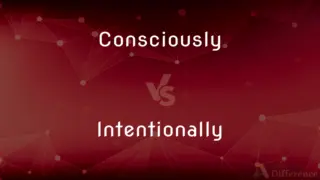Hair Dryer vs. Hair Iron — What's the Difference?
Edited by Tayyaba Rehman — By Fiza Rafique — Published on November 16, 2023
Hair Dryer is a device blowing warm air to dry and style hair. Hair Iron is an appliance using heat to change the hair's structure, styling it.

Difference Between Hair Dryer and Hair Iron
Table of Contents
ADVERTISEMENT
Key Differences
Hair Dryer, generally known for its utility to expedite the hair-drying process, emits warm or cool air, aiding not only in drying but also in basic styling of the hair. On the flip side, Hair Iron, distinctly recognized for its ability to alter the hair's structure via heat, effectively allows styling in straight, wavy, or curled forms, providing a different scope of styling when compared to hair dryers.
Considering convenience, a Hair Dryer can be viewed as an essential tool to rapidly dry hair, making it a frequent appliance in daily haircare routines. In contrast, Hair Iron, while potentially usable daily, might be chosen for more specific or occasional styling due to its intense heat and structural styling capacities, thus differentiating them in terms of regularity and application of use.
In terms of styling capabilities, the Hair Dryer typically allows for volumizing, smoothing, and basic shaping of the hair, establishing a foundation for various styles. Conversely, Hair Iron, with its heat-intensive technology, facilitates precise styling like straightening, curling, or crimping, thus offering a more specialized and defined styling outcome compared to a hair dryer.
Comparison Chart
Primary Use
Drying hair
Styling hair
Damage Potential
Generally lower
Higher due to direct heat
ADVERTISEMENT
Typical Usage
Regular/daily
Occasional/specific styling
Styling Capacity
Basic shaping and volumizing
Precise styling
Heat Application
Indirect (blown air)
Direct (hot surfaces)
Compare with Definitions
Hair Dryer
A Hair Dryer can provide a smooth hair finish.
The hair dryer helped her smooth out the frizz before the party.
Hair Iron
Hair Iron applies direct heat to the hair.
Careful with the hair iron, she avoided keeping it on one strand too long.
Hair Dryer
Hair Dryers often come with varied attachments.
She attached a diffuser to her hair dryer to enhance her curls.
Hair Iron
Hair Iron requires cautious use to prevent damage.
She always applied a heat protectant before using her hair iron.
Hair Dryer
Hair Dryers emit adjustable-temperature air.
For a gentle dry, he set the hair dryer to blow cool air.
Hair Iron
Hair Iron can create defined styles like curls.
Using the hair iron, she skillfully crafted elegant curls.
Hair Dryer
A Hair Dryer assists in basic hair styling.
He used a hair dryer to add volume to his hair.
Hair Iron
Hair Iron comes in various types for different styles.
He used a crimping hair iron to add textured waves to his hair.
Hair Dryer
A Hair Dryer quickly dries wet hair.
After the shower, she used the hair dryer to avoid going out with wet hair.
Hair Iron
Hair Iron changes hair structure through heat.
She utilized the hair iron to straighten her wavy hair.
Common Curiosities
Can a Hair Iron be used on wet hair?
No, a hair iron should typically be used on dry hair to prevent damage.
What is the primary function of a Hair Dryer?
The primary function of a hair dryer is to blow air to dry and minimally style hair.
Does a Hair Dryer provide any styling capabilities?
Yes, a hair dryer can assist in basic styling, such as smoothing and volumizing hair.
What are common types of Hair Iron?
Common types of hair iron include straighteners, curling irons, and crimping irons.
Can a Hair Dryer be used daily?
Yes, a hair dryer can be used daily, preferably with heat settings adjusted to minimize damage.
Can Hair Iron cause hair damage?
Yes, hair iron can cause damage due to direct heat, especially without careful use and protection.
How to choose the right Hair Dryer for my hair type?
Choose a hair dryer considering your hair type, desired features, and any inclusive attachments.
Is a Hair Dryer suitable for all hair types?
Generally, a hair dryer is suitable for all hair types, with varied attachments aiding specific needs.
How does a Hair Iron alter hair style?
A hair iron uses direct heat to alter the hair’s structure, enabling styling like straightening or curling.
What attachments might come with a Hair Dryer?
Hair dryer attachments can include diffusers, concentrators, and comb nozzles for varied styling.
How to prevent burns while using a Hair Iron?
Ensure safe use of a hair iron by utilizing heat-resistant gloves and being mindful during use.
Is it necessary to use a heat protectant with a Hair Iron?
Absolutely, using a heat protectant while using a hair iron helps minimize heat damage.
Can a Hair Dryer work on curly hair?
Yes, with a diffuser attachment, a hair dryer can effectively work on curly hair.
Does Hair Iron work on very short hair?
Hair iron can work on short hair, depending on the length and type of iron used.
Is it possible to use a Hair Dryer without an attachment?
Yes, a hair dryer can be used without attachments, providing a general blow-dry.
Share Your Discovery

Previous Comparison
Brushed Nickel vs. Stainless Steel
Next Comparison
Consciously vs. IntentionallyAuthor Spotlight
Written by
Fiza RafiqueFiza Rafique is a skilled content writer at AskDifference.com, where she meticulously refines and enhances written pieces. Drawing from her vast editorial expertise, Fiza ensures clarity, accuracy, and precision in every article. Passionate about language, she continually seeks to elevate the quality of content for readers worldwide.
Edited by
Tayyaba RehmanTayyaba Rehman is a distinguished writer, currently serving as a primary contributor to askdifference.com. As a researcher in semantics and etymology, Tayyaba's passion for the complexity of languages and their distinctions has found a perfect home on the platform. Tayyaba delves into the intricacies of language, distinguishing between commonly confused words and phrases, thereby providing clarity for readers worldwide.












































